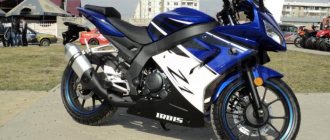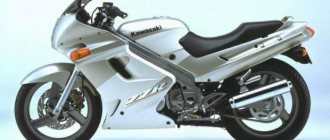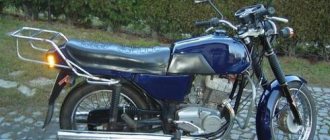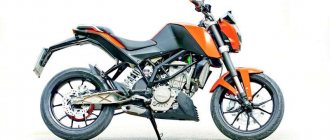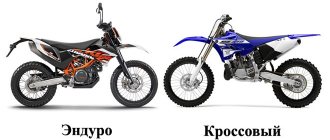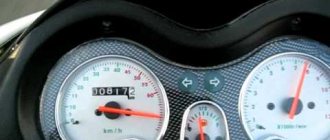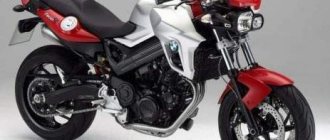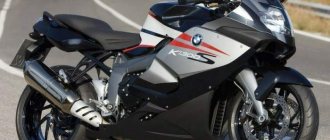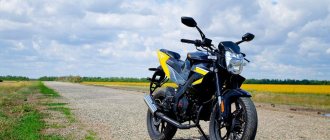Technical characteristics of the Honda cbr 600 f4i motorcycle
| Engine volume, cm3 | 599 |
| Power, hp | 110 |
| Number of cylinders | 4 |
| Number of cycles | 4 |
| Maximum speed, km/h | 260 |
| Gasoline consumption, l | 6,4 |
| Tank volume, l | 18 |
| Transmission | 6-speed |
| Dimensions, mm | 685/1135/2041 |
The four-cylinder engine is liquid cooled. Each cylinder has four valves. The motor runs without sudden movements. The revs pick up smoothly. When you reach more than 7000 rpm and switch to sport mode, jerks are not observed. The engine is started using an electric starter. The ignition system is completely electronic. The motorcycle has a three-phase generator.
The gearbox, in general, is not very different from Honda sports models. The gears switch on clearly. The box is reliable in operation.
The front suspension consists of a telescopic fork with a travel of 120 mm, and the rear suspension is a pendulum fork with a travel of 120 mm. The suspension is adjustable to suit your driving style and road conditions. Brake system: hydraulic disc. The front brake consists of two discs, and the rear one - of one.
I once said the same thing: “Hondas don’t break.” But I'll start from the beginning. I bought my Ike in June 2013. The mileage on the dashboard was 29,000, although it’s hard to believe such mileage on a 10-year-old motorcycle. Over the course of a season and a half in Moscow and the surrounding area, as well as several short long-distance trips, I drove another 31,000. During this time, the motorcycle didn’t particularly bother me, I didn’t even change the consumables much. I serviced it completely immediately after purchase, and then only the oil and filters. The tires and chain had to be changed closer to the 30 thousand mark. Although there were some unpleasant moments.
But the bike began to literally crumble towards the end of last season. And I opened this season only yesterday - June 3rd. I’ll tell you about what happened and how much it took to restore it.
Problems.
It all started with the voltage regulator relay. The motorcycle, after a long trip through traffic jams, when the speed was spinning almost at idle for half an hour, stopped starting. When I pressed the ignition button, the device went out and went to reboot. The starter didn't even think about turning. At first I was scared, thinking the worst. I started checking the terminals and fuses. In the end, I didn’t find anything suspicious, people helped, they started me up with a pusher, I walked along the already empty Moscow Ring Road, the battery was recharged and didn’t bother me for a week. I decided that maybe the terminal had come loose or something. However, during another long traffic jam, my turn signals first stopped working, and when I clicked on the high beams, the tidy went out. The engine was running. I stopped at a gas station, checked the terminals, fuses, wires, then ran around with the motorcycle for about 15 minutes, finally started it and didn’t turn it off all the way to the garage. I didn't have a battery charger. I consulted with different people both in person and online. For some reason, everyone said that the problem was 100% in the battery, but they didn’t even mention the relay - like the charge is coming, that means it’s working. As a result, I bought a new battery, installed it, everything naturally became fine, and I rode for almost 2 more weeks and was happy. But since, in fact, my relay was still dying, which was no longer providing sufficient charge, the battery slowly discharged. Buying relays in stock in Moscow was also a story, and they then cost 4-5 thousand. During the time it took me to find it, I became an ace in starting a motorcycle from a pushrod - a couple of meters of run was enough.
But, as they say, trouble does not come alone. As soon as I changed the relay, the next day, when accelerating in second gear around 7-8 thousand rpm, my speed suddenly jumped to the cutoff for half a second, and the acceleration at that time, on the contrary, disappeared. Then I drove on normally. Then I tested it all day - everything worked perfectly. What it was, I didn’t understand then. A few days later it happened again. Then it began to appear 3-4 times a day. After a week, this happened with every acceleration. Since this happened only in second gear and precisely during intense acceleration, there could be no doubt that my zizer was in the box. But it was already autumn, depending on the weather, there was a month or a month and a half left until the end of the season, and no one would make a box in a week. I decided to finish the ride like this and do it in the winter. After some time, the jumps in revolutions stopped - the transmission simply began to fly into neutral. And after a couple of days, crashes occurred even without intense acceleration - just at rpm above 4000. As a result, I didn’t even engage second gear: clutch, two clicks up and off we went. True, in traffic jams, because of this, I had to turn the first gear, because the motorcycle would not move in third.
At the very end of the season, at the end of October, when white flies began to fly, another strange thing appeared. In first gear, at steady revs, the motorcycle twitched barely noticeably. It was so imperceptible that the second number did not feel anything at all. I couldn't understand the reason. I thought it might also be a problem with the gearbox, because I didn’t notice this in other gears. But since there was nothing left to ride, I didn’t do anything anymore. I decided that in winter we’ll check it at the service center in one go.
Repair.
For the first 3 months the motorcycle spent the winter in a warm box. In February, it was finally sent to service. There they carried out a more or less complete diagnosis. It turned out that there was 0 compression in one cylinder... They opened the head, and there...
At first there was talk of replacing half the engine, including even the pistons. It was cheaper to either buy a whole contract engine or sell the motorcycle for parts and buy a new one. But we looked further and thought that we shouldn’t change it. The price was comparable to a used engine, but with a guarantee of normal operation. Because it is not known how long another used engine will be destroyed and what will have to be repaired in it.
In the end, we agreed on rings, valve stem seals, liners, gaskets and a bunch of other little things like washers, rings, etc. Plus, about 70% of the box was replaced: 5 gears, forks, a copy shaft and all sorts of washers, bearings, etc. The result was 63 positions. The service had to clean everything from carbon deposits, grind the valves, assemble and set everything up. I looked for and ordered spare parts myself, since directly through large stores it cost 125 thousand with delivery (at that time the dollar had just crossed the threshold of 100 rubles and cost about 70). It took a month to find people who could buy it cheaper. Moreover, different spare parts cost different things for everyone. For example, one fork cost 2500, another 4000, and in the store 3500 (all prices include delivery). But this other one had some inserts that were 2 times cheaper than the others.
The tale is told quickly, but the deed is not done quickly. It took another month to deliver everything. The last spare part was received around April 20th. Next came the assembly, in which I did not participate, but simply waited for the result.
Now for the prices: Almost 75,000 were spent on all spare parts. Which is clearly better than the original 125k. Plus consumables (oil, filters, coolant, spark plugs, brake fluid, pads front/rear, tapered bearings for the steering wheel) - 16,000. Plus work - 44,000. Total 135,000 rubles.
I bought the motorcycle for 220...
By the way, I even thought about selling it at the end of the season and buying something newer. But with the box destroyed, I didn’t want to sell it for just 150k. And now we can assume that I have a 12-year-old motorcycle worth 300 thousand. But at least you can ride for another season or two =)
Honda doesn't break, they said...
Flaws:
- The timing chain tensioner can ring in the range of 2000-5000 rpm, but this does not affect the chain in any way.
- At high speeds, you have to practically lie down on the tank, which leads to some discomfort in the back when driving for a long time in this position.
- Weak head light. Eliminated by replacing conventional lamps with xenon ones.
There are certain difficulties in which class the Honda cbr 600 f4i sport belongs to. On the one hand, the characteristics of a sports tourist can be traced, and, on the other hand, the characteristics of the engine and gearbox correspond specifically to a sportbike. In terms of ergonomic and aerodynamic characteristics, this is more of a sport-tourist. But, in terms of its behavior, it is a pure city sportbike.
Motorcycle suspension and possible problems with it
No matter how good and reliable the Sibierka is, the pendant, like a cat, has only a few lives. Under harsh operating conditions, even it begins to act up and show its character. This is especially true for the loaded rear wheels and suspension on almost every sportbike. During inspection, due attention should be paid to the wheel bearings, rear sprocket and steering column, especially if there is a suspicion that the former owner liked to roll in a sharp style along with wheelies, stoppies and other acrobatic sketches.
Replacing these elements will easily fit into the standard price list of a middle-class motorcycle service. In fact, you can do everything yourself if your hands grow from the right place and you have a manual at hand.
Motorcycle modifications
Over the years of production, the sportbike has undergone a number of changes. Here are the main ones:
- Honda CBR600RR 2003. Start of production and sales. The following year there were no noticeable changes, only various little things like changed numbers of some spare parts. Structurally, the Honda CBR600RR 2004 and 2003 model years do not differ in any way, as can be clearly seen from the photo.
- Honda CBR600RR 2005. Second generation release. The motorcycle received an updated frame, swingarm, as well as improved suspension and brakes, while losing 10 kg of weight.
- Honda CBR600RR 2007. Third generation, with which came a new engine. Power, however, increased by only 1 hp, but the bike received an electronic steering damper, and overall began to handle noticeably better thanks to the reduced wheelbase.
- Honda CBR600RR 2008. The production of the third generation continued, but the available color range was significantly expanded.
- Honda CBR600RR 2009. The engine was slightly improved, adding a couple of “horses”, and the installation of an ABS system, working in conjunction with combined brakes, began.
- 2013 - Production of the fourth generation began, and the design was noticeably redesigned. The suspension has been heavily modified. Since then, there have been no noticeable changes until 2021, so we can expect the fifth generation to be released soon.
Comparison with analogues
The Honda CBR600RR limited edition motorcycle is widely popular among Russian racers. Its closest competitors are devices developed and produced also in Japan, the following models:
- Suzuki GSX-R600 costing from 750 thousand rubles;
- Kawasaki Ninja ZX-6R 636 ABS priced from 768 thousand rubles;
- Yamaha YZF-R6 costing from 862 thousand rubles.
A comparison of the described motorcycle with its closest competitors in terms of price category and technical characteristics demonstrates approximate parity. At the same time, this device has a number of features that distinguish it from the general background:
- Since 2009, ABS has been installed on the motorcycle for the first time, which has significantly increased the efficiency of the braking system.
- Newly shaped plastic fairings with improved aerodynamic properties were used.
- The upgraded engine provides excellent performance especially in the high range from 8,000 to 12,000 rpm.
In addition to the new technical solutions, several new color schemes have been added to the motorcycle's paint job. The device’s closest competitors also strive to catch up with the leader and are constantly improving the level of their products.
Modifications
All changes in the sports version concerned reducing the weight of the motorcycle.
In 2001, simultaneously with the launch of injection versions, the CBR600F F4 Sport appeared. The amount of plastic on the model was reduced, and the center stand was also removed. This allowed the overall weight to be reduced by several kg.
But it should also be noted that American traffic rules require you to indicate speed in miles. But reconfiguring the control unit per km is quite simple from authorized Honda representatives. Temperature readings are also easy to switch, and the gauges work equally well without any additional adjustments.
Photos and videos
What else you can read:
- 2021 Kia Optima – Affordable Business Class
- How to determine that the steering rack is knocking and why it happens
- TOP 9 cars in terms of reliability and quality
- Volga 5000 GL 2021 – The time has come
- 4 reviews of Toyota Corolla with photos in a new body
- Porsche Panamera - Your mom will be proud!
- Kia Optima 2021 will receive body restyling
- Mitsubishi Pajero Sport 2021 – The Awakening of Technology.
Characteristic features of the unit
The aerodynamic characteristics of this model are pragmatic - oncoming air flows are not just dispersed, they are absorbed by the front air intakes, which significantly improves the responsiveness of the carburetor throttle. And the combined, aggressively smooth relief of all fairings creates a certain futuristic appearance of the motorcycle and the “rider” sitting on it. And even the passenger in the back does not spoil the picture at all - he has the same landing position as the pilot. Everything looks very organic and seamless.
Anyone who has an obvious or hidden love for bikes, riding the CBR f4i, will not miss the opportunity to bring the tachometer needle to 10,000 rpm. And only then will he think about the possible need to brake sharply. But this is all right: 4-piston brakes, double-disc in front and single-disc in rear, are many times more sensitive and at the same time more effective than their predecessors.
Not without criticism, of course... Particularly picky “users” express dissatisfaction with the lack of rear visibility. This refers to the rear view mirrors. Although, it’s true, they could be spaced horizontally a little more, increasing the length of the mirror holders by at least a centimeter each. The convex protective covering of the speedometer and tachometer also causes criticism - in bright sunshine, the readings of these instruments are almost invisible due to glare. The same applies to the LCD daily mileage counter, which without a mirror backing - in daylight - its readings are not visible. But even more discomfort when driving is caused by the absence of a fuel level indicator (there is only a reserve capacity sensor). Despite the general focus of such equipment on convenience and comfort, the underseat luggage rack is very small, which does not allow you to carry something bulky with you.
Dimensions and weight
The dry weight of the car is 170 kg, while the fuel tank volume is 18 liters. Taking into account the average consumption of 6 liters per hundred, the gas tank capacity should be absolutely sufficient. In terms of dimensions, the car occupies an average position in the class.
000_moto_0511_042
Honda CBR600F: sports tourer, 2011, 600 cm³, 102 hp, 211 kg, from RUB 450,000.
Honda CBR600F: sports tourer, 2011, 600 cm³, 102 hp, 211 kg, from RUB 450,000.
“Comrades! The workers’ and peasants’ revolution, the need for which the Bolsheviks kept talking about, has come true.” To paraphrase the leader of the world proletariat, I can say “Citizen motorcyclists, a replacement for the good old CBR600F4i has arrived!”
The premiere of the updated CB600F Hornet (“Moto” No. 4–2011) had just died down when its “dressed” modification was presented to journalists for comprehensive review. Strictly speaking, the CBR600F differs from it only in the presence of full-fledged grand prix plastic and clip-ons instead of a bent steering wheel. Suspension settings, gear ratios, injection maps, and even the gas tank and rear plastic with a seat - everything was “moved” from the Hornet without any changes. Such experiments are not new. Suzuki, which built the GSX1250 from the classic “Bandit,” and Yamaha, which built the XJ6 Diversion F sports tourer from the XZ6 naked, expanded the model range in the same way. It is obvious that Honda, when creating such “hybrids”, also does not invest sporting ambitions in completely budget devices. They remain the same quiet cars for every day, just “with checkers”. In the sense that in the eyes of potential buyers of such equipment (and these are mostly novice motorcyclists who are still afraid of real “sports” and mature guys who, on the contrary, no longer need a “hellish hurricane”), a motorcycle with developed wind protection is simply more comfortable than "naked".
From the very first meters, skepticism about the capabilities of the motorcycle quickly dissolved. It seems that a naked bike was built from “Siberian”, and not vice versa. The “triangle” of the landing turned out to be a little sharper than on the Hornet (the clip-ons are installed lower, and the footrests and seat remained in their places), but at the same time, it was the increased tilt of the body that made the landing “just what the doctor ordered” for the existing weight distribution and dimensions of the device. However, the tilt of the body is so slight that the back and wrists do not get tired even after several hundred kilometers of continuous riding. Due to the greater load on the front wheel, the brakes, which on the Hornet clearly lacked information, gained the necessary efficiency and feedback. For the same reason, the motorcycle became much more willing to turn into turns and generally obey the pilot. It’s easier to squeeze through traffic jams thanks to a narrower steering wheel. The only hindrance is the mirrors, mounted on plastic on long legs, but they can be folded “along the sides.”
Unfortunately (and for some, perhaps fortunately), the Sibir’s engine is just as phlegmatic as that of its city “brother”. Up to 8000 rpm you can safely count crows and look at the young ladies passing by, and only after reaching this o. It is clearly not intended for “hellish produbas”, but in quiet urban or suburban mode you can limit yourself to third gear: it covers the speed range of 40–120 km/h quite calmly, the engine is very elastic. For a “six hundred” the operating range is more than decent. In short, the CBR is perfect for everyday city and intercity driving.
Tuning and expenses
Honda CBR600 F4i is a real stadium for lovers of upgrades and tuning. Today in European and American catalogs you can find a bunch of different “gadgets” for this motorcycle, which can affect the speed, and also do not touch this option in any way. From creative plastics to everyone's favorite stand that's a must-have for long-distance travel. There is also a large selection of direct-flow mufflers and zero filters. There is, however, one point - experienced professionals advise installing Power Commander along with the “easy breathing” system. The fact is that the changed pressure at the inlet and outlet significantly worsens the operation of the engine with standard brains.
60-tooth driven sprockets, cross handlebars with brackets, as well as auxiliary brake calipers, cage bars and yokes - all this can be found in almost every street catalog that respects itself and its clients.
The range of tourist body kits is also extensive. Gel saddles and pannier systems, touring glasses and much more that a truck driver needs.
What remains to be added? The only thing is that a motorcycle of this class is, perhaps, one of the best options that is suitable for almost everyone who wants to ride on two wheels.


